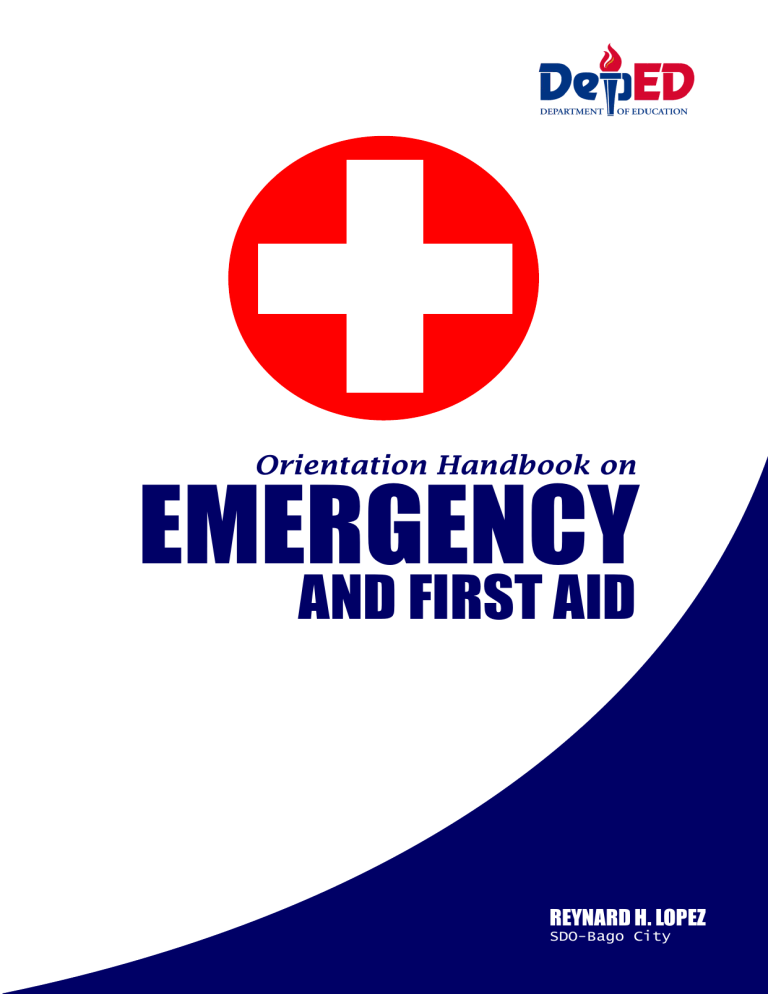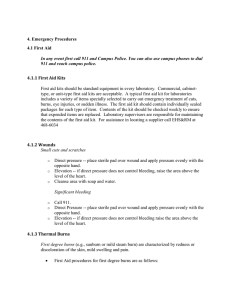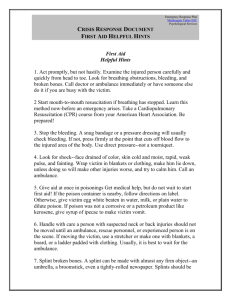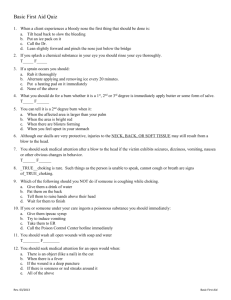
Orientation Handbook on EMERGENCY AND FIRST AID REYNARD H. LOPEZ SDO-Bago City RATIONALE OBJECTIVES Ÿ This orientation handbook serves as a reference guide for basic First Aid. Ÿ It is designed to help DepEd teachers all over the country to facilitate the teaching and learning process in providing first aid lessons to their students. Ÿ It aims to inform the teachers and students about emergency situation and how to act upon these circumstances. 3P’s of FIRST AID PRESERVE PREVENT PROMOTE Life Deterioration Recovery MEDICAL EMERGENCIES 1 ASSESS The Situation: WHAT TO DO 3A’s Is it safe? If the scene is safe, GO ON, if the scene is unsafe, BACK OFF. 2 ALERT Call an ambulance or activate the emergency action plan. Call for help or any bystander 3 ATTEND TO THE VICTIM Check for life-threatening conditions first. (ABC) 1. Airway 2. Breathing 3. Circulation The Victim: Is he/she responsive? WHAT IS FIRST AID? First aid is emergency care given immediately to an injured person. The purpose of first aid is to minimize injury and future disability. In serious cases, first aid may be necessary to keep the victim alive. WHAT’S IN A FIRST AID KIT? Kits vary in contents but most kits have the following: Ÿ first aid/burn cream Ÿ band-aids / adhesive Ÿ antibiotic ointment bandages Ÿ face shield or barrier Ÿ gauze pads and tape Ÿ mask for providing CPR Ÿ scissors, cold pack Ÿ first aid instruction booklet Ÿ wound bandage/compress Ÿ BP apparatus Ÿ eye pads / eyewash Ÿ face mask Ÿ forceps / tweezers Ÿ disposable thermometers Ÿ solution Ÿ flashlight Ÿ alcohol Ÿ cotton applicator ADULT / CHILD CHOKING SEVERE AIRWAY BLOCKAGE 1 Choking occurs when someone's airway suddenly gets congested, either fully or partly, so they can't breathe. This information applies to adults and children over 1 year old. When victim is responsive . Survey the scene, if the scene is safe go on; if the scene is unsafe back off. Introduce yourself, Quickly ask, “are you choking?" If the victim nods yes, or is unable to speak, or cough – act quickly. Stand behind the victim.Place the dominant feet in between the legs of patient. Make a fist and place the thumb side of that hand against the victim’s abdomen, just above the navel and below the ribs (xyphoid process).Grasp fist with the other hand. Quickly chest thrust inward and upward into the abdomen. Repeat thrusts until the object is expelled or the victim becomes unresponsive. . . . . . When victim is unresponsive . . . . . . . . . . Survey the scene Hey, hey are you okay? Call for help or any bystanders. If needed, place the victim to the ground and alert the Emergency Operation Center (EOC). Check the object if visible; if not visible. If the object is visible, remove it using your pointing finger (for adult) or pinky finger (for child/infant). Keep the object and transport the patient to the nearest hospital for further assessment. Begin chest thrusts as you would with CPR. How? place your palm heel or the hand in between the chest. Each time the airway is opened look for the object in the victim's throat and if you can see it, remove it – being careful not to lodge the object further into the victim’s throat. Continue chest thrusts until the victim shows signs of breathing or responsiveness. Place the patient in left side lying position. Perform head to toe examination. Refer to the nearest hospital. MINOR WOUNDS, BRUISES AND INJURIES 2 MINOR WOUNDS Minor wounds include abrasions, lacerations, punctures, and incisions. First Aid: Signs and Symptoms: ® break, cut or opening in the skin ® bleeding – may be minor, moderate or severe ® bruising and pain ® infection ® progressing shock £ If there is bleeding, do not apply tourniquet and apply direct pressure with a clean cloth or absorbent pad. £ Wash the area with running water and antibacterial soap and clean until there appears to be no foreign matter in the wound. £ Cover the area with an adhesive bandage or gauze wrap or any clean cloth and elevate above the heart. BRUISING Bruising is caused by broken blood vessels leaking blood under the skin or no break in skin. Bruising can be minimal or large and severe. Signs and Symptoms: ® pain and swelling ® discoloration: new bruising will be dark purple / older bruising will fade to greenish-yellow First Aid: £ Apply ice to injury to reduce pain, bleeding, and swelling. £ To prevent frostbite to the injured area, place a thin towel or cloth between the skin and ice. Limit ice application 15 to 20 minutes on, and 20 minutes off. CRUSH INJURY Occurs when a body part is subjected to a high degree of force or pressure. Signs and Symptoms: ® pain and swelling ® discoloration and sometimes deformity First Aid: £ Apply ice just as you would with a bruising injury. £ If pain is severe and does not lessen with ice or there is decreased sensation, weakness or paleness of the skin in the affected area, seek emergency care. SEVERE BLEEDING AND SHOCK 3 SEVERE BLEEDING Severe external bleeding is a life-threatening condition needing vital first aid. The human body depends upon blood circulating around the body to transport oxygen to organs and tissues such as the heart, brain and skin. If a person drops a lot of blood, their circulation system may fail and be incapable to deliver enough oxygen. This can lead to shock and possibly death. Common reasons of bleeding include road traffic crashes, equipment accidents, knife wounds and gunshot injuries. Apply Direct Pressure ® Rip or cut away clothing so the wound can be seen. ® Place an absorbent pad directly over the wound. ® Apply firm and direct pressure over the wound. ® The victim can assist if he/she is able. Apply Direct Bandage ® Wrap a conforming bandage securely over the pad to maintain pressure and hold the gauze in place. Apply direct pressure and elevate above the heart level. ® The bandage should be loose enough so a finger can slip under the bandage. SHOCK Shock develops when not enough blood flows to the vital organs of the body. Victims with shock may stop responding. Common causes of shock are: ® severe bleeding ® heart attack or other heart problem ® severe allergic reaction Signs and Symptoms: ® dizziness, faint or weak feeling ® ® ® ® ® rapid, shallow breathing anxiety, restlessness, agitation, or confusion cool and clammy to the touch pale or grayish skin thirst nausea or vomiting ® nervous system injuries ® severe burns ® dehydration First Aid ® Keep victim lying flat with feet slightly elevated, if possible. ® Cover person to keep them warm but prevent overheating. ® Ensure an open airway for the victim and adequate breathing. ® Monitor victim and administer CPR, if necessary. MINOR AND MAJOR BURNS 4 BURNS Burns are tissue injury that results from heat, overexposure to the sun or other radiation, or chemical or electrical contact. Burns can be minor medical problems or life-threatening emergencies. The treatment of burns depends on the position and extent of the damage. Sunburns and small scalds can usually be treated at home. Deep or widespread burns need immediate medical attention. Some people need treatment at specialized burn centers and month-long follow-up care. ® Burn percentages = Degree of Burn = Severity ® Thermal burns are caused by sun, ® ® ® ® ® ® ® fire, hot liquids or objects and sometimes hot gases. Chemical burns are caused by contact with wet or dry chemicals. Electrical burns are caused by contact with electrical wires, current, or lightning. Burns on the face, hands, feet, and genitals can be particularly serious. Burns can cause tremendous damage to the body. They can cause extreme pain, scarring, massive infection, organ failure, and even death. A rescuer’s highest priority is personal safety. If a victim is on fire, tell him/her to STOP, DROP, and ROLL. If a victim is in contact with electricity DO NOT TOUCH them until the source of electricity has been shut off or shut off technical source before touching victims. MINOR BURNS Signs and Symptoms: ® pain, redness ® swelling, blisters First Aid ® Survey the scene. Introduce yourself that you are a train first aider. ® Expose the burn. ® Cool burns with cold water and continue until pain lessens. ® After cooling, cover with a wet, sterile bandage or clean dressing. ® Protect from friction /pressure. ® DO NOT pop blisters or apply any ointment or other substance. MAJOR BURNS Signs and Symptoms: ® dry/leathery, white, or blackened, charred skin First Aid ® Assess/Alert/Attend to any lifethreatening problems. ABC (Airway, Breathing, Circulation) ® Call an ambulance or EOC. Call for help. ® If caused by a liquid chemical, flush with running water right away if you are a fully trained first aid provider. ® Cover with wet sterile bandage. BITES, STINGS, & EYE INJURIES 5 BITES & STINGS Bites and stings that could require first aid care can occur from a wide variety of sources. Most bites and stings only cause minor discomfort and can easily be treated by a first aid provider. However, bites and stings from venomous snakes, insects or animals can cause intense pain and swelling. First Aid Signs and Symptoms: ® redness ® swelling ® pain ® itching ® nausea ® breathing problems ® If stung by bee, first remove stinger. ® Remove jewelry and constrictive clothing. ® Wash the area with soap and clean water (running water). ® Cover the area with an adhesive bandage or gauze wrap. ® Remove the sting using a card. ® Apply ice if needed to reduce pain and swelling. EYE INJURIES Eye injuries can range from minor irritations to severe and sight-threatening. Injuries are frequently caused by objects in the eye, burns, and blunt force injuries. Any of these conditions or situations can lead to permanent loss of vision. Signs and Symptoms: ® pain, redness, stinging ® burning, itching ® bleeding/bruising in or around eyes ® sensitivity to light ® decreased or double vision ® loss of vision First Aid ® Rinse the eye with saline solution or tap water if saline is not available. ® Do not try to remove objects. ® Do not allow the victim to rub or apply pressure to the injured eye. ® Cover the eye lightly with a gauze pad or clean cloth. ® Seek medical attention. NOSE BLEED & HEAT EXHAUSTION 6 NOSE BLEED Nosebleed is the loss of blood from the tissue that lines the inside of your nose The medical name for a nosebleed is epistaxis. Most nosebleeds are not serious and can be handled by a first aid responder. In some cases, nosebleeds can indicate a more serious condition that may require ongoing medical attention. First Aid ® Sit upright and lean forward. By remaining upright, you reduce blood pressure in the veins of your nose. This discourages further bleeding. Sitting forward will help you avoid swallowing blood, which can irritate your stomach and might cause choking. ® Pinch the nose firmly. Use your thumb and index finger to pinch your nostrils shut. ® Breathe through your mouth. Continue to pinch for five to 10 minutes. HEAT EXHAUSTION Heat exhaustion is a condition that occurs when a person is exposed to high temperatures, particularly when combined with high humidity, and strenuous physical activity. Without prompt treatment, heat exhaustion can lead to heat stroke, a life-threatening condition. Signs and Symptoms: ® cool, moist skin with goose bumps when in the heat ® heavy sweating ® faintness ® dizziness, fatigue, weak, rapid pulse ® low blood pressure upon standing ® nausea or headache First Aid Stop all activity and rest. Move to a cooler place. Drink cool water or sports drinks. Contact your doctor if your signs or symptoms worsen or if they don't improve within one hour. Seek immediate medical attention if your body temperature reaches 104°F (40°C) or higher. ® ® ® ® References Ÿ Eighteenth Congress of the Republic of the Philippines. Senate S.No.1186. An Act Mandating the Department of Education (DepEd) to incorporate First Aid in the Physical Education (PE) Subject in Elementary and Secondary School Curricula in both Public and Private School Ÿ Ÿ May 10, 2018. DM 084, S. 2018. Partnership with Philippine Red Cross for the Promotion of First Aid, Youth Development, Volunteerism, Health and Safety Community Resilience and the International Humanitarian Law Ÿ Ÿ DepEd Order No. 033 S. 2021. School-based Disaster Preparedness and Response Measures for Tropical Cyclone, Flooding and Other Weather Related Disturbances and Calamities About the Author Reynard H. Lopez is a Teacher III in Ramon Torres National High School, SDO Bago City, Negros Occidental, Philippines. He had his Bachelor's degree of Secondary Education Major in P.E., Health and Music in Central Philippine University, Iloilo and took his Master in Education Major in Music, Arts, Physical Education and Health in University of St. La Salle, Bacolod. He is now teaching in his dear Alma Mater, RTNHS in the MAPEH Department and is handling Special Program in Sports. He was the Sports Coordinator of his current workplace for four consecutive years (2015 - 2018). Additionally, he is a member of DRRM RTNHS since 2015 until the present. In 2019, he was appointed as Regional Coordinator of the Aloysian Publication. Published by the LEARNING RESOURCES MANAGEMENT SECTION (Schools Division of Bago City) Philippines COPYRIGHT 2022 Section 9 of Presidential Decree No. 49 provides: “No copyright shall subsist in any work of the Government of the Republic of the Philippines. However, prior approval of the government agency of office wherein the work is created shall be necessary for exploitation of such work for profit.” This material has been developed with the aid of the SDO Disaster Risk Reduction Management Office and SDO Health and Nutrition Section, implemented by Curriculum and Learning Management Division (CLMD) of the Department of Education Region VI-Western Visayas. It can be reproduced for educational purposes and the source must be clearly acknowledged. The material may be modified for the purpose of translation into another language but the original work must be acknowledged. Derivatives of the work including creating an edited version, an enhancement or a supplementary work are permitted provided all original work is acknowledged and the copyright is attributed. No work may be derived from this material for commercial purposes and profit. Author Reynard H. Lopez Illustration Ronald M. Castillo Layout: Roxan E. del Castillo Quality Assurance Team: Stephen John S. Faina, RN Malewaro A. Gamilla Emily V. Zerrudo, MD Girlie S.Panaguiton Raymund L. Santiago, PhD. This first digital edition has been produced for print and online distribution within the Department of Education, Philippines via the Learning Resources Management Development Systems (LRMDS) Portal by Region VI. http://lrmds.deped.gov.ph All Rights Reserved 2022



